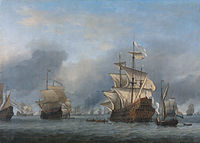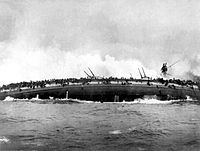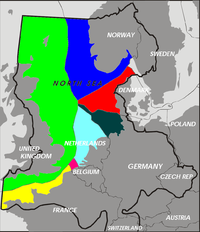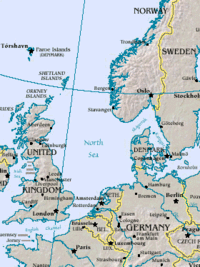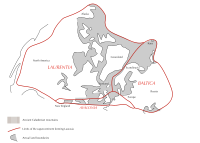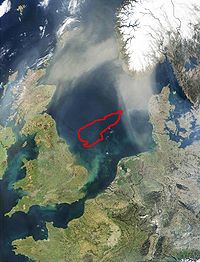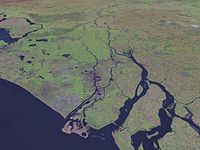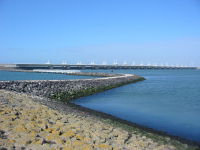
North Sea
Background to the schools Wikipedia
This selection is made for schools by a children's charity read more. To compare sponsorship charities this is the best sponsorship link.
| North Sea | |
|---|---|
| Location | Atlantic Ocean |
| Coordinates | 56°N 03°E |
| Primary sources | Forth, Ythan, Elbe, Weser, Ems, Rhine/ Waal, Meuse, Scheldt, Spey, Tay, Thames, Humber, Tees, Wear, Tyne |
| Basin countries | Norway, Denmark, Germany, Netherlands, Belgium, France and the U.K. (England, Scotland) |
| Max length | 600 mi (970 km) |
| Max width | 350 mi (560 km) |
| Surface area | 222,000 mi² (575,000 km²) |
| Average depth | 308 ft (94 m) |
| Max depth | c.2,165 ft/660 m |
| Water volume | 94 000 km |
The North Sea is a marginal, epeiric sea of the Atlantic Ocean on the European continental shelf. It is more than 600 miles (970 km) long and 350 miles (560 km) wide, with an area of around 222,000 square miles (570,000 km2). A large part of the European drainage basin empties into the North Sea including water from the Baltic Sea. The North Sea connects with the rest of the Atlantic through the Dover Strait and the English Channel in the south and through the Norwegian Sea in the north.
The North Sea averages about 100 m (325 ft) deep, with a maximum depth of 700 m (2300 ft) and in some areas shallows can be a mere 15 m deep. The North Sea lies above what used to be the triple junction between three continental tectonic plates in the early Paleozoic Era. Movement on the faults associated with these tectonic phenomena can still cause earthquakes and small tsunamis. The sea's coastal features are the result of glacial movements rather than tectonics. Deep fjords and sheer cliffs mark the coastline of the northern part of the North Sea, whereas the southern coasts consist of sandy beaches and mudflats. These flatter areas are particularly susceptible to flooding, especially as a result of storm tides. Elaborate systems of dikes have been constructed to protect coastal areas.
The development of European civilization has been heavily affected by the maritime traffic on the North Sea. The Romans and the Vikings sought to extend their territory across the sea. Both the Hanseatic League and the Netherlands sought to dominate commerce on the North Sea and through it to access the markets of the world. Britain's development as a sea power depended heavily upon its dominance in the North Sea, where some of its rivals sought power, first the Netherlands and finally Germany and to a lesser extent Russia and the Scandinavian nations. Commercial enterprises, growing populations, and limited resources gave the nations on the North Sea the desire to control or access the North Sea for their own commercial, military, and colonial ends.
Its importance has turned from the military to the economic. Traditional economic activities, such as fishing and shipping, have continued to grow and other resources, such as fossil fuels and wind energy, have been discovered and developed.
Naming
The name of the North Sea originates from its relationship to the land of the Frisians. Frisia lies directly to the south of the North Sea, to the west of the East Sea (Oostzee, the Baltic Sea), to the north of the former South Sea (Zuiderzee, today's IJsselmeer) and the today- reclaimed Middle Sea (Middelzee). The name “North Sea” is attested in Middle High German and probably harks back to the name given by the Frisians, who settled on its south coast. Even the early Spanish name was Mar del Norte.
From the point of view of the German Hanseatic towns of the Middle Ages, the sea to the east was the “East Sea” (Baltic Sea in German is literally the Ostsee), and the sea to the north, the North Sea. The spread of maps used by Hanseatic merchants popularized this name throughout Europe. Other common names in use for long periods were Mare Frisia, and Mare Frisicum, Oceanum- or Mare Germanicum as well as their English equivalents, Frisian Sea and German Ocean or Sea.
"German Sea" or "Germanic Sea" (from the Latin Mare Germanicum) was commonly used in English and other languages along with "North Sea", until the early eighteenth century. By the late nineteenth century, both "German-" and "Germanic Sea" were rare, scholarly usages.
History
Early history
The first records of marine traffic on the North Sea come from the Roman Empire, which began exploring the sea in 12 BC. Great Britain was formally invaded in 43 AD and its southern areas incorporated into the Empire, beginning sustained trade across the North Sea and the English Channel. The Romans abandoned Britain in 410 and in the power vacuum they left, the Germanic Angles, Saxons, and Jutes began the next great migration across the North Sea during the Migration Period, conquering and displacing the native Celtic populations.
The Viking Age began in 793 with the attack on Lindisfarne and for the next quarter-millennium the Vikings ruled the North Sea. In their superior longships, they raided, traded, and established colonies and outposts on the Sea's coasts.
As Viking dominance waned, trade on the North Sea came to be controlled by the Hanseatic League. The League, though centred on the Baltic Sea, had important outposts on the North Sea. Goods from all over the world flowed through the North Sea on their way to and from the Hanseatic cities.
By 1441, the Netherlands had risen as an economic and shipping power to rival the League. By the 16th Century, the Netherlands were the leading economic power. The North Sea was a hotbed of commerce and shipping connecting far-flung colonies with markets all over Europe.
Early modern history
Dutch power during her Golden Age was a concern for growing England, which saw its future in the merchant marine and overseas colonies. This conflict was at the root of the first three Anglo-Dutch Wars between 1652 and 1673. By the end of the War of Spanish Succession in 1714, the Dutch were no longer a major player in European politics.
Britain's naval supremacy faced its only real challenge before the 20th Century from Napoleonic France and her continental allies. In 1800, a union of lesser naval powers, called the League of Armed Neutrality, formed to protect neutral trade during Britain's conflict with France. The British Navy defeated the combined forces of the League of Armed Neutrality in the Battle of Copenhagen in 1801 in the Kattegat. Britain later defeated the French Navy in the Battle of Trafalgar off the coast of Spain.
20th Century
Tensions in the North Sea were again heightened in 1904 by the Dogger Bank incident, in which Russian naval vessels mistook British fishing boats for Japanese ships and fired on them, and then upon each other. The incident, combined with Britain's alliance with Japan and the Russo-Japanese War led to an intense diplomatic crisis. The crisis was defused when Russia was defeated by the Japanese and agreed to pay compensation to the fishermen.
During the First World War, Great Britain's Grand Fleet and Germany's Kaiserliche Marine faced each other on the North Sea, which became the main theatre of the war for surface action. Britain's larger fleet was able to establish an effective blockade for most of the war that restricted the Central Powers' access to many crucial resources. Major battles included the Battle of Heligoland Bight, the Battle of the Dogger Bank, the Battle of Jutland, and the Second Battle of Heligoland Bight. Britain, though not always tactically successful, maintained the blockade and thus kept the High Seas Fleet in port. Conversely, the German navy remained a threat that kept the vast majority of Britain's capital ships in the North Sea.
The Second World War also saw action in the North Sea, though it was restricted more to submarines and smaller vessels such as minesweepers, and Fast Attack Craft. On April 9, 1940, the Germans initiated Operation Weserübung in which almost the entire German fleet was focused north toward Scandinavia in the North Sea as well as in the Skagerrak and Kattegat. Throughout the German occupation of Norway, the Shetland Bus operation ran secretly across the North Sea from Great Britain to Norway. First, Norwegian fishing boats were used, and then three 100 foot (30 m) submarine chasers. (see also: HNoMS Hitra).
In the last years of the war and the first years thereafter, huge volumes of weapons were disposed-of by being sunk in the North Sea. These comprised mainly grenades, land mines, naval mines, bazookas, cartridges, and some chemical weapons. Though estimates vary widely, hundreds of thousand tons of munitions were sunk.
After the war, the North Sea lost much of its military significance because it is bordered only by NATO member-states. The North Sea gained significant economic meaning in the 1960s as the states on the North Sea began to exploit its oil and gas resources.
Political status
The countries bordering the North Sea all claim the twelve nautical miles of territorial waters within which they have exclusive fishing rights. Iceland, however, as a result of the Cod Wars has exclusive fishing rights for 200 mi (320 km) from its coast, into parts of the North Sea. The Common Fisheries Policy of the EU exists to coordinate fishing rights and assist with disputes between EU states and the EU border state of Norway.
After the discovery of mineral resources in the North Sea, Norway claimed its rights under the Continental Shelf Convention. The other countries on the sea followed suit. These rights are largely divided along the median line. The median line is defined as the line "every point of which is equidistant from the nearest points of the baselines from which the breadth of the territorial sea of each State is measured." The ocean floor border between Germany, the Netherlands, and Denmark was only reapportioned after protracted negotiations and a judgment of the International Court of Justice.
Environmental concerns led to the MARPOL 73/78 Accords, which created 25 mi (40 km) and 50 mi (40 and 80 km) zones of protection. The Convention for the Protection of the Marine Environment of the North-East Atlantic is established for the preservation of the ocean in the region. Germany, Denmark, and the Netherlands have a trilateral agreement for the protection of the Wadden Sea, or mudflats, which run along the coasts of the three countries on the southern edge of the North Sea.
Geography
For the most part, the sea lies on the European continental shelf. The only exception is a narrow area of the northern North Sea off Norway. The North Sea is bounded by Great Britain to the west and the northern and central European mainland to the east and south, including Norway, Denmark, Germany, the Netherlands, Belgium, and France.
In the south-west, the North Sea becomes the English Channel beyond the Straits of Dover. In the east, it connects to the Baltic Sea via the Skagerrak and Kattegat. In the north, it opens in a widening funnel shape to the Norwegian Sea, which lies in the very north-eastern part of the Atlantic.
Apart from the obvious boundaries formed by the coasts of the countries which border it, the North Sea is generally considered to be bounded by an imaginary line from Lindesnes, Norway to Hanstholm, Denmark running towards the Skagerrak. However, for statistical purposes, the Skagerrak and the Kattegat are sometimes included as part of the North Sea. The northern limit is less well-defined. Traditionally, an imaginary line is taken to run from northern Scotland, by way of Shetland, to Ålesund in Norway. According to the Convention for the Protection of the Marine Environment of the North-East Atlanticof 1962 it runs further to the west and north from longitude 5° West and latitude 62° North, at the latitude of Geirangerfjord in Norway.
The surface area of the North Sea is approx. 575,000 square kilometres (222,000 sq mi) with a volume of around 54,000 cubic kilometres (13,000 cu mi). This places the North Sea at the 13th largest sea on the planet.
Geology
Geological history
The bed of the North Sea forms two basins. The main northern one lies to the north of a ridge between Norfolk and Frisia, and had its origin in the Devonian. The southern basin, if not flooded, would drain towards the Strait of Dover and thence to the English Channel. This basin dates from the Carboniferous.
During the most recent glaciation, the Devensian much of the northern basin was covered by the ice sheet, and the remainder, including the southern basin, was tundra. However, during the Cromerian interglacial, there was a natural dam of chalk, the Weald-Artois Anticline." Although the ridge probably collapsed during the Kansan glaciation it still formed the highest part of the land bridge between continental Europe and Great Britain.
The Storegga Slides were a series of underwater landslides, in which a piece of the Norwegian continental shelf slid into the Norwegian Sea. The immense landslips occurred between 8150 BC and 6000 BC, and caused a tsunami up to 20 m (65 ft) high that swept through the North Sea, having the greatest effect on Scotland and the Faeroe Islands.
Plate tectonics
The North Sea lies above what used to be the triple junction between three continental tectonic plates in the early Paleozoic Era. Later, in the Mesozoic Era, a North-South trending rift valley or graben formed down the middle of the North Sea. Fault lines along the English Channel cause occasional earthquakes, which can result in damage to structures on land. The axial grabens of the North Sea also form a tectonically active area. Northwestern Europe's continental slope is subject to landslides from earthquakes. Although not a site of major earthquakes or tsunamis, there are intraplate earthquakes which result in the uplifting of the continental crust causing landslides. The Dover Straits earthquake of 1580 is among the first recorded in the North Sea and caused extensive damage in both France and England both through its tremors and a tsunami. The largest earthquake ever recorded in the United Kingdom was the 1931 Dogger Bank earthquake, which measured 6.1 on the Richter Scale and caused a tsunami that flooded parts of the British coast.
The North Sea is located at a triple junction of three continental plates formed during the Palaeozoic: Avalonia, Laurentia and Baltica. Baltica is now the eastern coastline and the Scandinavian countries; Avalonia consists of the southern and western North Sea coast along England, northern Germany and France; and Laurentia marks the northern perimeter of the North Sea with the Atlantic Ocean.
Geological features
The Norwegian trench reaches from the Stad peninsula in Sogn og Fjordane to the Oslofjord. The trench is between 50 and 95 km (30-60 mi) wide and hundreds of meters deep. Off the Rogaland coast, it is 250 - 300 m (820-980 ft) deep, and at its deepest point, off Arendal, it reaches 700 m (2300 ft) deep as compared to the average depth of the North Sea, about 100 m (325 ft). The trench is not a subduction-related oceanic trench. It is mainly a deep erosional scour, while the Western part follows the North-South line of an old Rift Valley formed during the Jurassic and Cretaceous periods, also known as the Viking Graben.
To the East of Great Britain, the vast morainic plate of the Dogger Bank rises up to 15 to 30 m deep.
The Silver Pit is a valley-like depression 45 km (27 mi) east of Spurn Head in England that has been recognized for hundreds of years by fishermen. Nearby is the Silverpit crater, a controversial structure, which may be a geological structure or may be an impact crater.
"The Long Forties" denotes an area of the northern North Sea that is fairly consistently forty fathoms (73 m) deep (thus, on a nautical chart with depth shown in fathoms, a long area with many "40" notations). It is located between the northeast coast of Scotland and the southwest coast of Norway, centred about 57°N 0°30′E.
The Broad Fourteens are an area of the southern North Sea that is fairly consistently fourteen fathoms (26 m) deep (thus a broad area with many "14" notations). It is located off the coast of the Netherlands and south of the Dogger Bank, roughly between longitude 3°E and 4°30′E and latitude 52°30′N and 53°30′N.
Around the edges of the North Sea are a number of sizable islands and archipelagos, including the Shetland, Orkney, and Frisian islands.
Biology and the environment
Fish
Copepods and other zooplankton are plentiful in the North Sea. These tiny organisms are crucial elements of the food chain supporting many species of fish. The North Sea is home to about 230 species of fish. Cod, haddock, whiting, saithe, plaice, sole, mackerel, herring, pouting, sprat, and sandeel are all very common and the target of commercial fishing. Due to the various depths of the North Sea trenches and differences in salinity, temperature, and water movement some fish reside only in small areas of the North Sea. The blue-mouth redfish and rabbitfish are a few examples of these.
Crustaceans are also commonly found throughout the sea. Norway lobster, deep-water prawns, and brown shrimp are all commercially fished, but other species of lobster, shrimp, oyster, mussels and clams are all found.
Birds
The coasts of the North Sea are home to nature reserves including the Ythan Estuary, Fowlsheugh Nature Preserve, and Farne Islands in the UK and The Wadden Sea National Parks in Germany. These locations provide breeding habitat for dozens of bird species. Tens of millions of birds make use of the North Sea for breeding, feeding, or migratory stopovers every year. Populations of Northern fulmars, Black-legged Kittiwakes, Atlantic puffins, razorbills, and a variety of species of petrels, gannets, seaducks, loons (divers), cormorants, gulls, auks, and terns, and many other seabirds make these coasts popular for birdwatching.
Marine mammals
The North Sea is also home to a variety of marine mammals. Common seals, grey seals can be found along the coasts and at marine installations and islands. The very northern North Sea islands like the Shetlands are occasionally home to a larger variety of pinnipeds including bearded, harp, hooded and ringed seals, and even walrus. North Sea cetaceans include Harbour porpoises, common dolphins, bottlenose dolphins, Risso's dolphins, long-finned pilot whales and white-beaked dolphins, minke whales, killer whales, and sperm whales
Environmental health
Historically, flamingos, pelicans, and Great Auk could be found along the southern shores of the North Sea. Gray whale also resided in the North Sea but were driven to extinction in the Atlantic in the 1600s. Other species have seen dramatic declines in population, though they are still to be found; right whales, sturgeon, shad, rays, skates and salmon among other species were common in the North Sea into the 20th Century, when numbers declined.
A variety of factors have contributed to decreasing populations of North Sea fauna. The introduction of non-indigenous species, industrial and agricultural pollution, overfishing and trawling, dredging, human-induced eutrophication, construction on coastal breeding and feeding grounds, sand and gravel extraction, offshore construction, and heavy shipping traffic all threaten marine life in the North Sea.
In recent decades action has been taken by the border countries to address many of these threats. The OSPAR convention was created in 1992 as and expansion of the 1972 Oslo Convention. It is managed by the OSPAR commission and has taken action to counteract the harmful effects of human activity on wildlife in the North Sea and preserve many endangered species.
Hydrology
Basic data
The salinity of the water is dependent on place and time of year but is generally in the range of 15 to 25 parts per thousand (ppt) around river mouths and up to 32 to 35 ppt in the northern North Sea, still generally lower than North Atlantic salinity, which averages around 35 ppt.
The water temperature varies depending on the influence of the Atlantic currents, water depth, and time of year, reaching 21 °C (77 °F) in summer and 6 °C (50 °F) in winter, though Arctic currents can be colder. The eastern side is both the warmest in summer and the coldest in winter. In the deeper northern North Sea, the water remains a nearly constant 10 °C (50 °F) year round because of water exchange with the Atlantic. The greatest temperature variations are found on the very shallow Wadden Sea coast, where ice can form in very cold winters.
The exchange of salt water between the North Sea and Atlantic occurs through the English Channel, as well as in the northern North Sea along the Scottish coast and through the Norwegian Sea. The North Sea receives fresh water not only from inflow of rivers but also from the low salinity Baltic Sea which drains into the North Sea via the Skagerrak. The North Sea rivers drain a land area of 841,500 km² (324,905 sq mi) and supply 296-354 km³ (71-85 cu mi) of fresh water annually. The Baltic rivers drain almost twice as large an area (1,650,000 km², 637,068 sq mi) and contribute 470 km³ (113 cu mi) of fresh water annually.
Around 185 million people live in the catchment area of the rivers that flow into the North Sea. These rivers drain a large part of Western Europe: a quarter of France, three quarters of Germany, nearly all of Switzerland, half of Jutland, the whole of the Netherlands and Belgium, the southern part of Norway, the Rhine basin of western Austria and the eastern side of Great Britain. This area contains one of the world's greatest concentrations of industry.
Water circulation
The main pattern to the flow of water in the North Sea is a counter-clockwise rotation along the edges. Water from the Gulf Stream flows in both through the English Channel towards Norway, and around the north of Britain, moving south along the British coast. From the south-moving current smaller currents are pulled off eastwards into the central North Sea. Another significant current sweeps south in the eastern part of the Sea. This is cold North Atlantic water and is strongest in late spring and early summer when the British offshore waters remain cool while the sea off the Netherlands and Germany starts warming up. Water from the Channel, and water flowing out of the Baltic Sea eventually move north along the Norwegian coast back into the Atlantic in what is called the Norwegian Current. The current moves at a depth of some 50 to 100 m (165-330 ft). It has a relatively low salinity due to the brackish water of the Baltic and the fresh water contributed by the rivers and the fjords. Though the current is, on average, cooler than the North Sea water as a whole, warmer water flowing in from the Channel mixed with the cooler waters of the Baltic and North Atlantic result in streams of widely varying temperatures within the current.
The mean residence time of water in the North sea is between 1 and two years. Water in the north is exchanged most quickly while water in the German Bight can flow in circles for years before being pulled northwards.
Fronts based on temperature, salinity, nutrients, and pollution can be clearly identified; they are more clearly defined in summer than in winter. Large fronts are the Frisian Front, which divides water coming from the North Atlantic from water originating in the English Channel, and the Danish Front, which divides southern coastal waters from water in the central North Sea. The inflow of water from large rivers mixes very slowly with North Sea water. Water from the Rhine and Elbe, for example, can still be clearly differentiated from sea water off the northwest coast of Denmark.
| River | Country | Discharge in m³/s | in cu ft/s |
|---|---|---|---|
| Rhine / Meuse | Netherlands | 2,524 | 89,134 |
| Elbe | Germany | 856 | 30,229 |
| Glomma | Norway | 603 | 21,295 |
| IJsselmeer | Netherlands | 555 | 19600 |
| Weser | Germany | 358 | 12,643 |
| Skjern Å | Denmark | 206 | 7275 |
| Firth of Tay (includes River Tay and River Earn) | Scotland | 203 | 7169 |
| Moray Firth (includes River Spey and River Ness) | Scotland | 168 | 5933 |
| Scheldt | Belgium/Netherlands | 126 | 4450 |
| Humber | England | 125 | 4415 |
| Forth | Scotland | 112 | 3955 |
| Ems | Germany | 88 | 3108 |
| Tweed | England | 85 | 3002 |
| Thames | England | 76 | 2684 |
Tides
The tides are caused by the tide wave from the North Atlantic, as the North Sea itself is too small and too flat to have its own tides. Ebb and flow alternate in a cycle of 12.5 hours. The tide wave, owing to the Coriolis effect, flows around Scotland and then counter-clockwise along the English coast, reaching the German Bight some 12 hours after arriving in Scotland. In so doing, it runs around three amphidromic points: a central point lies shortly before the Straits of Dover. It is formed by the tide wave which is transported through the English Channel. It influences the tides in the narrow area in the Southern Bight between southern England and the Netherlands. The other amphidromic system consists of two points close to each other, which form a tide wave. The two other points just off the coast of southern Norway and lying on a line between southern Denmark and the West Frisian Islands form one single area around which the tides flow. Its central point lies off the coast of Denmark at 55° 25' N, 5° 15' E.
As a result, the tidal range in southern Norway is less than half a metre (1.5 ft), but increases the further any given coast lies from the amphidromic point. Shallow coasts and the funnel effect of narrow straits increase the tidal range. The tidal range is at its greatest at The Wash on the English coast, where it reaches 6.80 m (22 ft). In shallow water areas, the real tidal range is strongly influenced by other factors, such as the position of the coast and the wind at any given moment or the action of storms. In river estuaries, high water levels can considerably amplify the effect of high tide.
Coasts
The western coasts of the North Sea are jagged, as they were stripped by glaciers during the ice ages. The coastlines along the southernmost part are soft, covered with the remains of deposited glacials which were left directly by the ice or have been redeposited by the sea. The Norwegian mountains plunge into the sea, giving birth, north of Stavanger, to deep fjords and archipelagos. South of Stavanger, the coast softens, the islands become fewer. The Eastern Scottish coast is similar, though less marked than Norway. Starting from Flamborough Head in the northeast of England, the cliffs become lower and are composed of less resistant moraine, which erodes more easily, so that the coasts have more rounded contours. In Holland, Belgium and in the East of England (East Anglia) the littoral is low and marshy. The East coast and south-east of the North Sea ( Wadden Sea) have coastlines that are mainly sandy and straight owing to longshore currents, particularly along Belgium and Denmark.
Northern fjords, skerries, and cliffs
The northern North Sea coasts bear the impression of the enormous glaciers which covered them during the Ice Ages and created a split, craggy coastal landscape. Fjords arose by the action of glaciers, which dragged their way through them from the highlands, cutting and scraping deep trenches in the land. During the subsequent rise in sea level, they filled with water. They very often display steep coastlines and are extremely deep for the North Sea. Fjords are particularly common on the coast of Norway.
Firths are similar to fjords, but are generally shallower with broader bays in which small islands may be found. The glaciers that formed them influenced the land over a wider area and scraped away larger areas. Firths are to be found mostly on the Scottish and northern English coasts. Individual islands in the firths, or islands and the coast, are often joined up by sandbars or spits made up of sand deposits known as “ tombolos”.
Towards the south the firths give way to a cliff coast, which was formed by the moraines of Ice Age glaciers. The horizontal impact of waves on the North Sea coast gives rise to eroded coasts. The eroded material is an important source of sediment for the mudflats on the other side of the North Sea. The cliff landscape is interrupted by large estuaries with their corresponding mud and marshy flats disrupt, notably the Humber and the Thames, in southern England.
In southern Norway, as well as on the Swedish Skagerrak coast, skerries are to be found. Formed by similar action to that which created the fjords and firths, the glaciers in these places affected the land to an even greater extent, so that large areas were carried away. The coastal brim (Strandflaten), which is found especially in southern Norway, is a gently sloping lowland area between the sea and the mountains. It consists of plates of bedrock, and often extends for kilometres, reaching under the sea, at a depth of only a few meters.
Southern shoals and mudflats
The shallow-water coasts of the southern and eastern coast up to Denmark were formed by Ice Age activity, but their particular shape is determined for the most part by the sea and sediment deposits. The Wadden Sea stretches between Esbjerg, Denmark in the north and Den Helder, Netherlands in the west. This landscape is heavily influenced by the tides and important sections of it have been declared a National Park. The whole of the coastal zone is shallow; the tides flood large areas and uncover them again, constantly depositing sediments. The Southern Bight has been especially changed by land reclamation, as the Dutch have been especially active. The largest project of this type was the diking and reclamation of the IJsselmeer.In the micro tidal area, (a tidal range of up to 1.35 m (4.43 ft)), such as on the Dutch or Danish coasts, barrier beaches with dunes are formed. In the mesotidal area (a tidal range of between 1.35 and 2.90 m (4.43-9.5 ft)), barrier islands are formed; in the macrotidal area (above 2.90 m (9.5 ft) tidal range), such as at the mouth of the Elbe, underwater sandbanks form.
The Dutch West Frisian and the German East Frisian Islands are barrier islands. They arose along the breakers’ edge where the water surge piled up sediment, and behind which sediment was carried away by the breaking waves. Over time, sandplates arose, which finally were only covered by infrequent storm floods. Once plants began to colonize the sandbanks the land began to stabilise.
The North Frisian Islands, on the other hand, arose from the remains of old Geestland islands, where the land was partially removed by storm floods and water action and then separated from the mainland. They are, therefore, often higher and their cores are less exposed to changes than the islands to the south. Beyond the core, however, the same processes are at work, particularly evident on Sylt, where in the south of the island, a break threatens, whilst the harbour at List silts up. The Danish Islands, the next in the chain to the north, arose from sandbanks. Right up into the twentieth century, the silting up of the islands was a serious problem. To protect the islands, small woods were planted.
The island of Helgoland was not formed by sediment deposition; in fact, it is considerably older and is composed of Early Triassic sandstone.
Storm tides
Storm tides threaten, in particular, the coasts of the Netherlands, Belgium, Germany, and Denmark. These coasts are quite flat, so even a relatively small increase in the water levels is sufficient to put large stretches of land under water. Storms from the west are especially strong, so the most dangerous places are on the south-east coast. Over the years, floods caused by storm tides have cost hundreds of thousands of lives and have significantly helped to shape the coast. Until early modern times, the number of victims from a single storm tide could be in the tens of thousands, even exceeding a hundred thousand, though to what extent these historically-reported casualties are accurate can only be estimated with difficulty.
The first recorded storm tide flood was the Julianenflut, on February 17, 1164. In its wake the Jadebusen began to form. Ancient records tell also of the First Marcellus Flood, which struck West Frieslandin 1219. A storm tide in 1228 is recorded to have killed more than 100,000 people. The Second Marcellus Flood also known as the Grote Mandrenke in 1362 hit the entire southern coast of the North Sea. Chronicles of the time again record more than 100,000 deaths as large parts of the coast were lost permanently to the sea, including the now legendary town of Rungholt (see Lost city).
In the twentieth century the North Sea flood of 1953 flooded several nations' coasts and cost more than 2000 lives. 315 citizens of Hamburg died in the North Sea flood of 1962. The "Century Flood" of 1976 and the "North Frisian Flood" of 1981 brought the highest water levels measured to date on the North Sea coast, but because of the dikes built and improved after the flood of 1962, these led only to property damage. A storm surge occurred on November 9, 2007, causing some flooding. The conditions were likened to those that had caused the damage and large loss of life in 1953. Fortunately, in 2007, nowhere near as much damage was caused although the Thames Barrier was closed twice to protect London.
Coastal preservation
The southern coastal areas were originally amphibious. The land included countless islands and islets which had been divided by rivers, streams, and wetlands and areas of dry land were regularly flooded. In areas especially vulnerable to storm tides, people settled first on natural areas of high ground such as spits and Geestland. As early as 500 BC, people were constructing artificial dwelling hills several meters high. It was only around the beginning of the High Middle Ages in 1200 AD that inhabitants began to connect single ring dikes into a dike line along the entire coast, thereby turning amphibious regions between the land and the sea into permanent solid ground.
The modern form of the dikes began to take form in the 17th and 18th centuries, built by private enterprises in the Netherlands. The Dutch dike builders exported their designs to other North Sea regions. The North Sea Floods of 1953 and 1962 were impetus for further raising of the dikes as well as the shortening of the dike line through land reclamation and river weirs so as to present as little surface area as possible to the punishment of the sea and the storms. Currently, 27% of the Netherlands is below sea level protected by dikes, dunes, and beach flats.
Coastal preservation today consists of several levels. The dike slope reduces the energy of the incoming sea, so that the dike itself does not receive the full impact. Dikes that lie directly on the sea are especially reinforced. The dikes have, over the years, been repeatedly raised, sometimes up to 10 m (32 ft) and have become flatter in order to better reduce the erosion of the waves. Modern dikes are up to 100 m (328 ft) across. Behind the dike, there runs an access road and generally a thinly inhabited area. In many places, another dike follows after several kilometers.
Where the dunes are sufficient to protect the land behind them from the sea, these dunes are planted with beach grass to protect them from erosion by wind, water, and foot traffic. See also:
- Flood control in the Netherlands
- Zuiderzee Works
- Delta Works
- Thames barrier
- Afsluitdijk
Economy
Oil and gas
In 1958, geologists discovered a natural gas field in Slochteren in the Dutch province of Groningen and it was suspected that more fields lay under the North Sea. However, at this point, the rights to natural resource exploitation on the high seas were still under dispute.
Test drilling began in 1966 and, then in 1969, Phillips Petroleum Company discovered the Ekofisk oil field (now Norwegian), which at that point was one of the 20 largest in the world and turned out to be distinguished by valuable low-sulfur oil. Commercial exploitation began in 1971 with tankers and after 1975 by a pipeline first to Cleveland, England and then after 1977 also to Emden, Germany. Since the discovery of North Sea oil in the 1970s, nicknames of Aberdeen have been the Oil Capital of Europe or the Energy Capital of Europe.
The exploitation of the North Sea oil reserves began just before the 1973 oil crisis, and the climb of international oil prices made the large investments needed for extraction much more attractive. In the 1980s and 1990s, further discoveries of large oil fields followed. Although the production costs are relatively high, the quality of the oil, the political stability of the region, and the nearness of important markets in western Europe has made the North Sea an important oil producing region. The largest single environmental catastrophe in the North Sea was the destruction of the offshore oil platform Piper Alpha in 1988 in which 167 people lost their lives.
With more than 450 oil platforms, the North Sea is the most important region in the world for offshore drilling. The British section of North Sea has the most platforms, followed by the Norwegian, Dutch, and Danish sections. Besides the Ekofisk oil field, the Statfjord oil field is also notable as it was the cause of the first pipeline to span the Norwegian trench. The largest natural gas field in the North Sea, Troll Field, lies in the Norwegian trench at a depth of 345 meters (1100 ft). A giant platform was required to access it. The German section has only two oil platforms, the larger of the two being the Mittelplate, and is the least developed North Sea border-country in this respect.
In 1999, extraction reached an all time high with nearly 6 million barrels (950,000 m³) of crude oil and 280,000,000 m³ (999,000,000 cu ft)of natural gas per day being taken. Today, the North Sea is a well-developed natural resource area, in which few new large discoveries are likely to be made. All the large oil companies have been involved in the extraction. But in the last few years, large companies like Shell and BP have discontinued extraction and, since 1999, the amount extracted has continually fallen due to depleted reserves.
The price of Brent Crude, one of the first types of oil extracted from the North Sea, is used today as a standard price for comparison for crude oil from the rest of the world.
Fishing
Fishing in the North Sea is concentrated in the southern part of the coastal waters. The main method of fishing is trawling.
Annual catches grew each year until the 1980s, when a high point of more than 3 million metric tons (3.3 million S/T) was reached. Since then, the numbers have fallen back to around 2.3 million tons (2.5 million S/T) annually with considerable differences between years. Besides the fish caught, it is estimated that 150,000 metric tons (165,000 S/T) of unmarketable by-catch are caught and around 85,000 metric tons (94,000 S/T) of dead and injured invertebrates.
In recent decades, overfishing has left many fisheries unproductive, disturbing the marine food chain dynamics and costing jobs in the fishing industry. Herring, cod and plaice fisheries may soon face the same plight as mackerel fishing which ceased in the 1970s due to overfishing. Since the 1960s, various regulations have attempted to protect the stocks of fish such as limited fishing times and limited numbers of fishing boats, among other regulations. However, these rules were never systematically enforced and did not bring much relief. Since then, the United Kingdom and Denmark, two important fishing nations, became members of the EU, and have attempted, with the help of the Common Fisheries Policy, to bring the problem under control.
Renewable energy
Due to the strong prevailing winds, countries on the North Sea, specifically England and Denmark, have used the areas near the coast of the sea for wind driven electricity production since the 1990s. The first wind turbines appeared off the English coast near Blyth in the year 2000 and then off the Danish coast in 2002 near Horns Rev. Others have been commissioned, including OWEZ and Scroby Sands and more are in the planning phase. Offshore wind farms have met some resistance, for instance in Germany. Concerns have arisen about shipping collisions and damage to the ocean ecology, particularly by the construction of the foundations. Furthermore, the distance from consumers leads to considerable energy losses in transmission. Nonetheless, the first deep water turbines in Scotland are under commissioning for Talisman Energy, who are installing two large machines 25 km (15 mi) offshore adjacent to the Beatrice oilfield. These turbines are 88 m (290 ft) high with the blades 63 m (210 ft) long and will have a capacity of 5 MW each, making them the largest in the world.
Energy production from the sea is still in its early stages. The southern parts of the North Sea, do not have tides, waves or currents strong enough to harness energy usefully. The Norwegian coast and the intersection with the Irish Sea could be found suitable for waves or ocean currents to provide power. First attempts for a power plant deriving electricity from the waves from 2003-2005 in Denmark were given up. The European Marine Energy Centre (EMEC) based at Stromness in Orkney is a Scottish Government-backed research facility. They have installed a wave testing system at Billia Croo on the Orkney mainland and a tidal power testing station on the nearby island of Eday. A small pilot-facility for the production of blue energy exists in the Norwegian city of Trondheim.
Tourism
The beaches and coastal waters of the North Sea are popular destinations for tourists. The Belgian, Dutch, German and Danish coasts are especially developed for tourism. While many of the busiest British beach resorts are on the South Coast, the British East Coast also has several important beach resorts.
Windsurfing and sailing are popular sports because of the winds. Because of the strong tides and areas of still water, the North Sea is more difficult to sail than the Baltic or the Mediterranean. Mudflat hiking, recreational fishing, and diving, including wreck diving, are all possible.
The climatic conditions on the North Sea coast are thought to be especially healthful. As early as the 19th century travellers used their stays on the North Sea coast as curative and restorative vacations (German:Kur-Urlaub). The sea air, temperature, wind, water, and sunshine are counted among the beneficial conditions that are said to activate the body's defences, improve circulation, strengthen the immune system, and have healing effects on the skin and the respiratory system. Besides the climate, thalassotherapy spas often use sea waters, mud, brine, algae, and sea salt for curative and restorative purposes.
One peculiarity of the North Sea tourism until the 1990s was the Butterfahrten. These were trips past the German tariff barriers onto the high seas for the purpose of purchasing items much more cheaply than they could be bought in Germany itself. The name comes from the time when butter was an expensive commodity and could be purchased more cheaply from Denmark. Other important wares were the heavily taxed goods like tobacco, spirits, and perfume.
Marine traffic
The North Sea is very important for marine traffic and experiences some of the densest concentrations of ships in the world. Great ports of the world are located along its coasts: Rotterdam, the third busiest port in the world by tonnage, Antwerp and Hamburg, both in the top 25, as well as Bremen/ Bremerhaven and Felixstowe, both in the top 30 busiest container seaports.
All major ports have easy access to the various sea lanes of the North Sea, which are monitored, well-regulated and regularly dredged. Traffic in the North Sea is especially difficult. Fishing boats, oil and gas platforms as well as merchant traffic from Baltic ports share routes on the North Sea surface area. The possibility of bottlenecks at the English Channel, which sees 400 vessels a day and the Kiel Canal, which averages more than 100 per day plus sport traffic (2003 figure) can add to the difficulty. The North Sea coasts are home to numerous canals and canal systems to facilitate traffic between and among rivers, artificial harbours, and the sea. Notable canals include the North Sea Canal, which shortened the connection between the port of Amsterdam to the North Sea,and the Kiel Canal, the world's busiest artificial waterway, which connects the North Sea and the Baltic.


